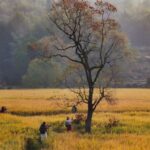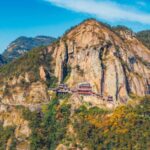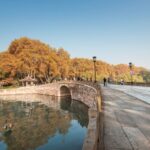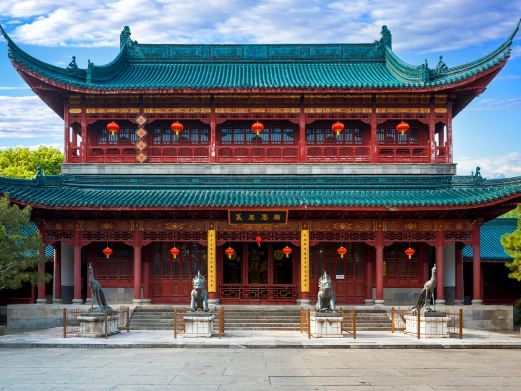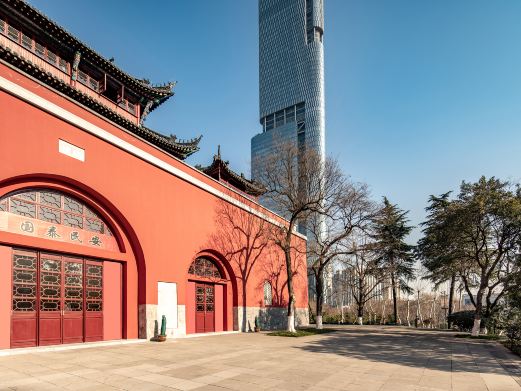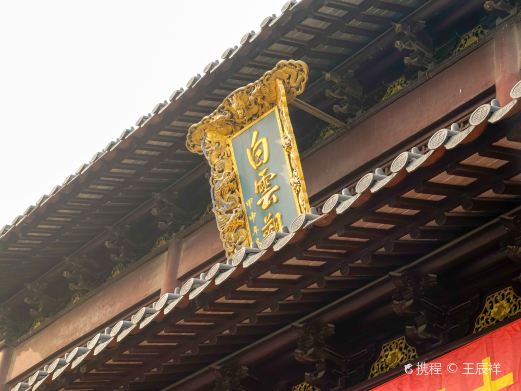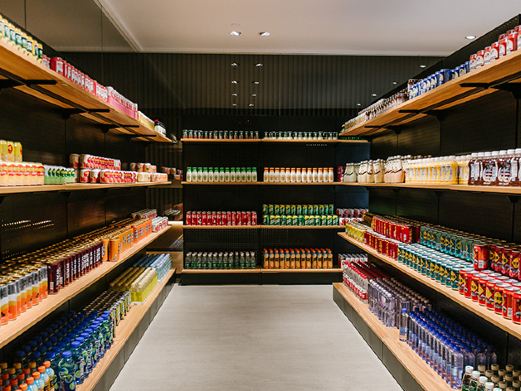The Guoqing Scenic Area is located 3 kilometers north of Tiantai County. The Guoqing Temple here is built according to the style drawn by Master Zhiyi, the founder of the Tiantai Sect. The ancient trees in the temple are towering. It is the ancestral court of the Tiantai Sect in China and also a must-see scenic spot for tourists visiting Tiantai. Although there are an endless stream of tourists coming here every day, Guoqing Temple still retains the quiet taste of Buddhism. There are no peddlers hawking incense here, but historical relics such as the Sui Pagoda, Tang camphor, and Song vine can still be seen. Walking among them gives people a feeling of ease and freedom. When you reach the gate of the ‘Guoqing Scenic Area’, walk along the main road. After passing a small patch of paddy fields, it is about five or six hundred meters before reaching the temple. If you don’t want to walk, you can also take an electric vehicle for transportation. On the right side of the memorial archway, there are 7 stone pagodas. Nearby, there is a path leading to the Sui Pagoda on the mountain. Climbing up the steps, you can reach the pagoda soon. Stopping and looking up at the mottled color of the pagoda body fills people’s hearts with tranquility. After admiring the Sui Pagoda, you can go down the mountain along the original road and continue to visit Guoqing Temple. If you want to take a panoramic view of Guoqing Temple, you might as well go up the mountain along the Xiake Ancient Road from the side of the Sui Pagoda for a broad view. Passing the Hanshi Pavilion, seeing the Tang camphor, and crossing the Fenggan Bridge is the mountain gate of Guoqing Temple. The four characters ‘Ancient Temple of the Sui Dynasty’ on the screen wall outside the temple are a remarkable sign of the temple, and many tourists take pictures here. After purchasing incense coupons at the ticket office nearby, you can enter the temple for a tour. The entire temple is built against the mountain and can be roughly divided into three parts from bottom to top. The temple gate is very small. The horizontal plaque reads ‘Guoqing Lecture Temple’, and it is often crowded due to too many tourists. The first hall you see after entering the temple is the Maitreya Hall. After that are the Yuhua Hall and the Mahavira Hall, which are places where tourists and pilgrims are relatively concentrated. Inside the Mahavira Hall, Sakyamuni Buddha and eighteen arhats are enshrined. It is the main building of the temple. On the right side of the Mahavira Hall, there is a path leading to the Sui plum. The thick and twisted branches of the ancient plum tree are also witnesses to the history of the temple. Passing the Meiting and going up higher is the Pharmacist Hall of the temple. Beside the hall is the Xizhang Spring. Going up further is the Guanyin Hall on a higher level. Inside, a statue of Thousand-Hand Guanyin is enshrined. In the nearby memorial hall for the founders of the Tiantai Sect in China and South Korea, statues of Master Zhiyi and other three founders from China and South Korea are enshrined. The inscriptions on the stone body and copper top of the Saddharma-pundarika Sutra pillar are also masterpieces. This is the highest point of the temple. Looking back at the Sui Pagoda at the foot of the mountain through the layers of eaves of the halls here has a special charm. Going down the mountain from the left, passing the Three Sages Hall and returning to the Mahavira Hall. Following the passage to the west not far away is the stele of Wang Xizhi’s single-stroke ‘goose’ character. The ‘goose’ character written in one stroke is perfectly natural. Continuing forward, there are buildings such as the Miaofa Hall, the Qielan Hall, and the Arhat Hall, which can be briefly browsed. Walking towards the exit, not far from the fountain in the Yule Kingdom, you can return to the Maitreya Hall near the exit. Although there are no more buildings to see along the way, the intertwined Song vines and the horizontally growing ancient trees on the roadside are also rare natural landscapes.
For those interested in experiencing a monastic lifestyle, you may partake in a vegetarian meal within the temple, typically served between 10:30 and 11:00 AM. The temple is open all year round from 07:00 to 16:00. It is advisable to avoid visiting during holidays and peak seasons, as fewer tourists allow for a deeper appreciation of the tranquility and serenity of Buddhist life.
